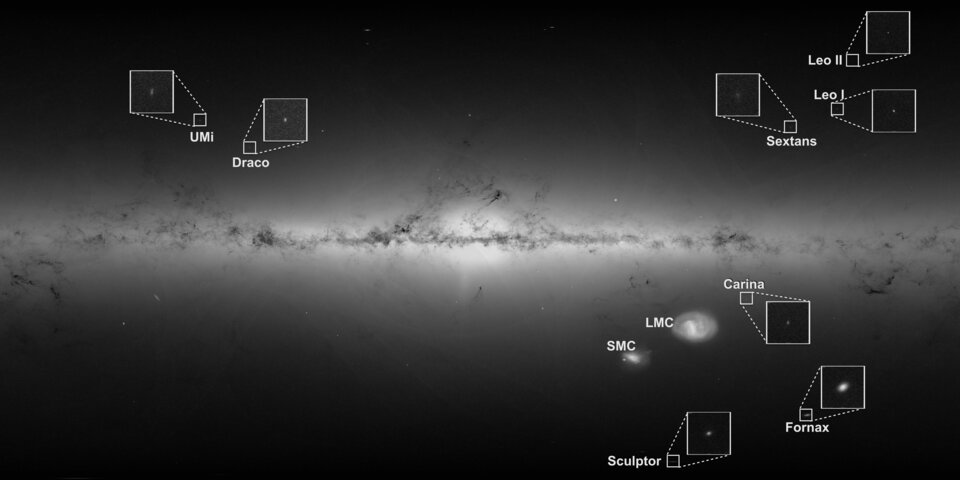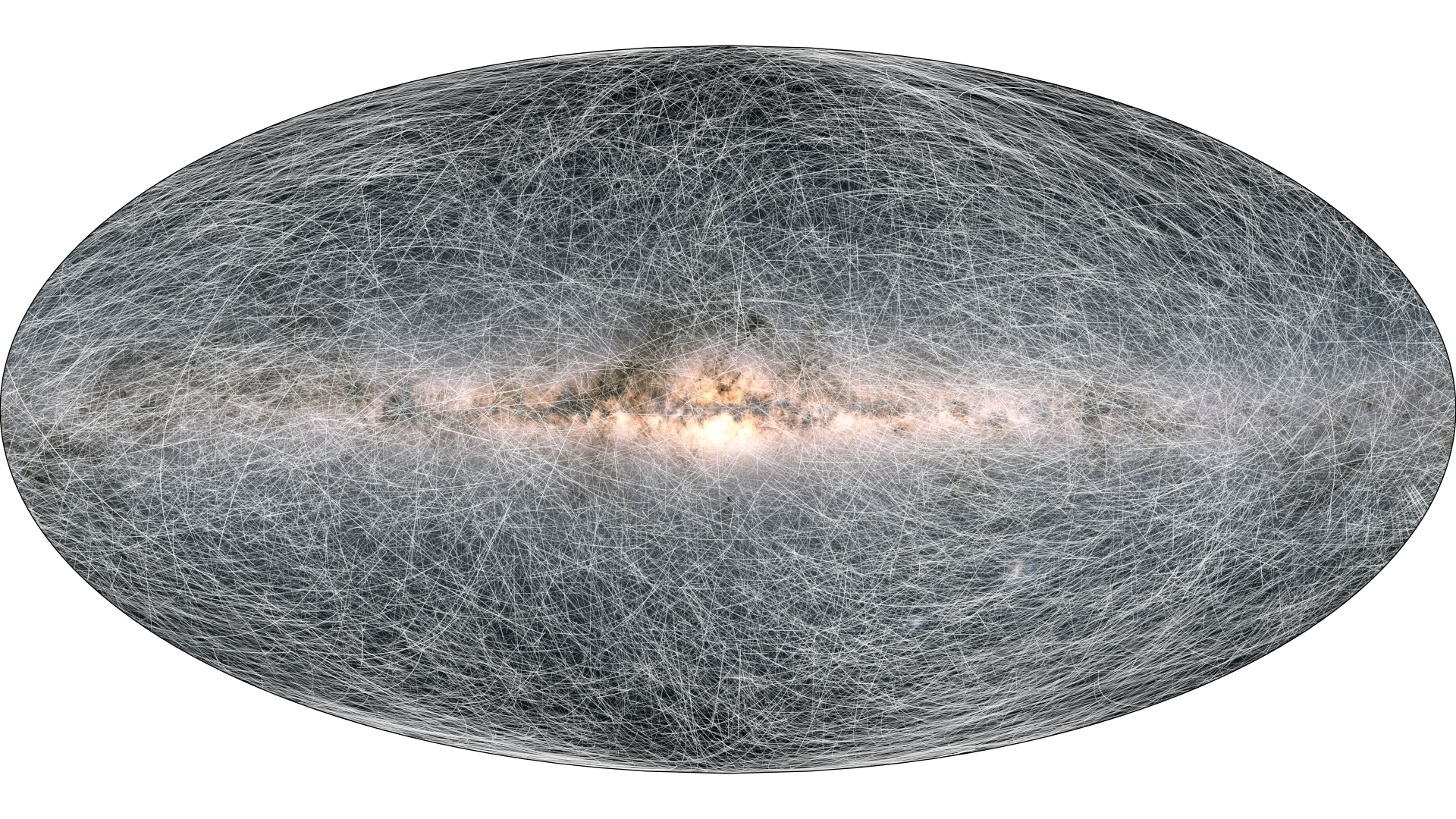

Dwarf galaxies around the Milky Way
24/11/2021
Data from ESA’s Gaia mission is re-writing the history of our galaxy-the Milky Way. What had traditionally been thought of as satellite galaxies to the Milky Way are now revealed to be mostly newcomers to our galactic environment.
A dwarf galaxy is a collection of between thousand and several billion stars. For decades it has been widely believed that the dwarf galaxies that surround the Milky Way are satellites, meaning that they are caught in orbit around our galaxy, and have been our constant companions for many billions of years. Now the motions of these dwarf galaxies have been computed with unprecedented precision thanks to data from Gaia’s early third data release and the results are surprising.

Gaia’s new data takes us to the Milky Way’s anticentre and beyond.
03/12/2020
The stars are in constant motion. To the human eye this movement – known as proper motion – is imperceptible, but Gaia is measuring it with more and more precision. The trails on this image show how 40 000 stars, all located within 100 parsecs (326 light years) of the Solar System, will move across the sky in the next 400 thousand years. These proper motions are released as part of the Gaia Early Data Release 3 (Gaia EDR3). They are twice as precise as the proper motions released in the previous Gaia DR2. The increase in precision is because Gaia has now measured the stars more times and over a longer interval of time. This represents a major improvement in Gaia EDR3 with respect to Gaia DR2. © ESA/Gaia/DPAC; CC BY-SA 3.0 IGO. Acknowledgement: A. Brown, S. Jordan, T. Roegiers, X. Luri, E. Masana, T. Prusti and A. Moitinho.
François Hammer, The Paris Observatory [Observatoire de Paris – PSL Centre de recherche en astronomie et astrophysique](FR) – Paris Sciences et Letters University [Université Paris Sciences et Lettres Université PSL] (FR), and colleagues from across Europe and China, used the Gaia data to calculate the movements of 40 dwarf galaxies around the Milky Way. They did this by computing a set of quantities known as the three-dimensional velocities for each galaxy, and then using those to calculate the galaxy’s orbital energy and the angular (rotational) momentum.
They found that these galaxies are moving much faster than the giant stars and star clusters that are known to be orbiting the Milky Way. So fast, that they couldn’t be in orbit yet around the Milky Way, where interactions with our galaxy and its contents would have sapped their orbital energy and angular momentum.
Our galaxy has cannibalised a number of dwarf galaxies in its past. For example, 8-10 billion years ago, a dwarf galaxy called Gaia-Enceladus was absorbed by the Milky Way. Its stars can be identified in Gaia data because of the eccentric orbits and range of energies they possess.
More recently, 4-5 billion years ago the Sagittarius dwarf galaxy was captured by the Milky Way and is currently in the process of being pulled to pieces and assimilated. The energy of its stars is higher than those of Gaia-Enceladus, indicating the shorter time that they have been subject to the Milky Way’s influence.
In the case of the dwarf galaxies in the new study, which represents the majority of the dwarf galaxies around the Milky Way, their energies are higher still. This strongly suggests that they have only arrived in our vicinity in the last few billion years.
The discovery mirrors one made about the Large Magellanic Cloud (LMC), a larger dwarf galaxy so close to the Milky Way that it is visible as a smudge of light in the night sky from the southern hemisphere.
 Large Magellanic Cloud. ESO’s VISTA telescope reveals a remarkable image of the Large Magellanic Cloud.
Large Magellanic Cloud. ESO’s VISTA telescope reveals a remarkable image of the Large Magellanic Cloud.
 Part of ESO’s Paranal Observatory the VLT Survey Telescope (VISTA) observes the brilliantly clear skies above the Atacama Desert of Chile. It is the largest survey telescope in the world in visible light, with an elevation of 2,635 metres (8,645 ft) above sea level.
Part of ESO’s Paranal Observatory the VLT Survey Telescope (VISTA) observes the brilliantly clear skies above the Atacama Desert of Chile. It is the largest survey telescope in the world in visible light, with an elevation of 2,635 metres (8,645 ft) above sea level.
The LMC was also thought to be a satellite galaxy of the Milky Way until the 2000s when astronomers measured its velocity and found that it was travelling too fast to be gravitationally bound. Instead of a companion, LMC is visiting for the first time. Now we know that the same is true for most of the dwarf galaxies too.
So will these newcomers settle into orbit or simply pass us by? “Some of them will be captured by the Milky Way and will become satellites,” says François.
But saying exactly which ones is difficult because it depends on the exact mass of the Milky Way, and that is a quantity that is difficult for astronomers to calculate with any real accuracy. Estimates vary by a factor of two.
The discovery of the dwarf galaxy energies is significant because it forces us to re-evaluate the nature of the dwarf galaxies themselves.
As a dwarf galaxy orbits, the Milky Way’s gravitational pull will try to wrench it apart. In physics this is known as a tidal force. “The Milky Way is a big galaxy, so its tidal force is simply gigantic and it’s very easy to destroy a dwarf galaxy after maybe one or two passages,” says François.
In other words, becoming a companion to the Milky Way is a death sentence for dwarf galaxies. The only thing that could resist our galaxy’s destructive grip is if the dwarf had a significant quantity of dark matter. Dark matter is the mysterious substance that astronomers think exists in the universe to provide the extra gravity to hold individual galaxies together.
And so, in the traditional view that the Milky Way’s dwarfs were satellite galaxies that had been in orbit for many billions of years, it was assumed that they must be dominated by Dark Matter to balance the Milky Way’s tidal force and keep them intact. The fact that Gaia has revealed that most of the dwarf galaxies are circling the Milky Way for the first time means that they do not necessarily need to include any dark matter at all, and we must re-assess whether these systems are in balance or rather in the process of destruction.
“Thanks in large part to Gaia, it is now obvious that the history of the Milky Way is far more storied than astronomers had previously understood. By investigating these tantalising clues, we hope to further tease out the fascinating chapters in our galaxy’s past,” says Timo Prusti, Gaia Project Scientist, ESA.
Science paper:
The Astrophysical Journal
See the full article here .

five-ways-keep-your-child-safe-school-shootings
Please help promote STEM in your local schools.
Objective
A global space astrometry mission, Gaia will make the largest, most precise three-dimensional map of our Galaxy by surveying more than a thousand million stars.
Mission
Gaia will monitor each of its target stars about 70 times over a five-year period. It will precisely chart their positions, distances, movements, and changes in brightness. It is expected to discover hundreds of thousands of new celestial objects, such as extra-solar planets and brown dwarfs, and observe hundreds of thousands of asteroids within our own Solar System. The mission will also study about 500 000 distant quasars and will provide stringent new tests of Albert Einstein’s General Theory of Relativity.
Gaia will create an extraordinarily precise three-dimensional map of more than a thousand million stars throughout our Galaxy and beyond, mapping their motions, luminosity, temperature and composition. This huge stellar census will provide the data needed to tackle an enormous range of important problems related to the origin, structure and evolutionary history of our Galaxy.
For example, Gaia will identify which stars are relics from smaller galaxies long ago ‘swallowed’ by the Milky Way. By watching for the large-scale motion of stars in our Galaxy, it will also probe the distribution of dark matter, the invisible substance thought to hold our Galaxy together.
Gaia will achieve its goals by repeatedly measuring the positions of all objects down to magnitude 20 (about 400 000 times fainter than can be seen with the naked eye).
For all objects brighter than magnitude 15 (4000 times fainter than the naked eye limit), Gaia will measure their positions to an accuracy of 24 microarcseconds. This is comparable to measuring the diameter of a human hair at a distance of 1000 km.
It will allow the nearest stars to have their distances measured to the extraordinary accuracy of 0.001%. Even stars near the Galactic centre, some 30 000 light-years away, will have their distances measured to within an accuracy of 20%.
The vast catalogue of celestial objects expected from Gaia’s scientific haul will not only benefit studies of our own Solar System and Galaxy, but also the fundamental physics that underpins our entire Universe.


